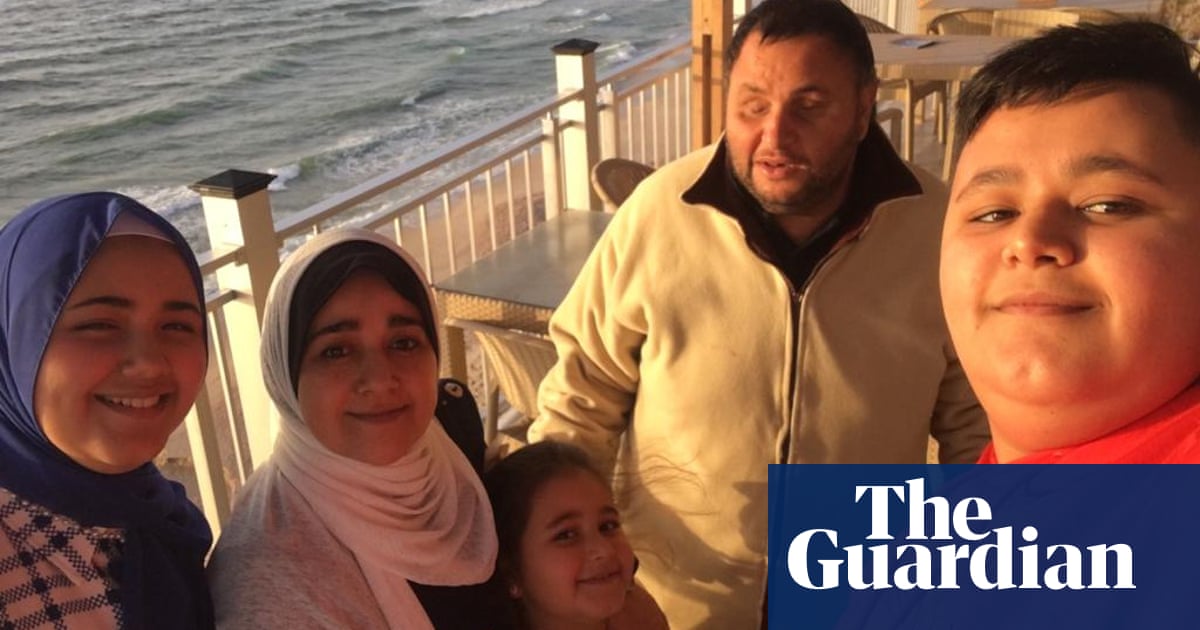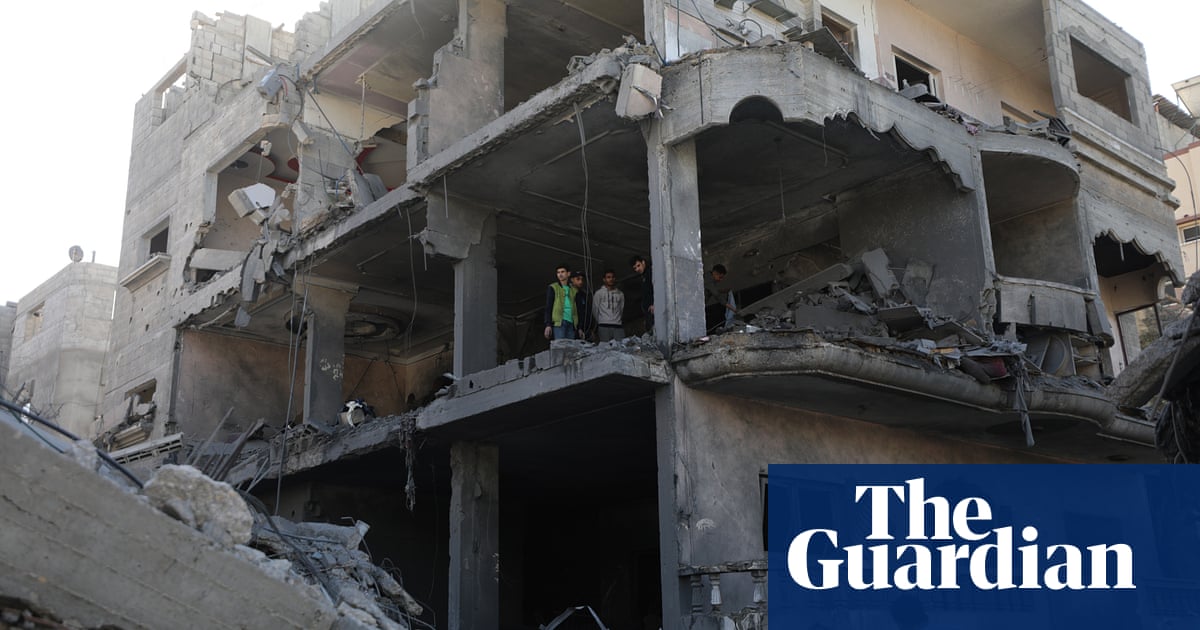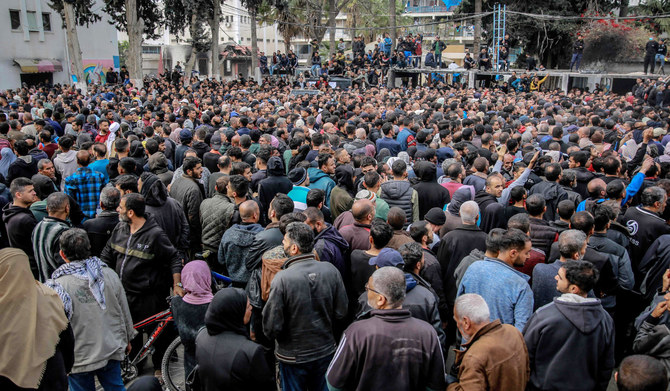
For some Palestinian Americans and their families who have been evacuated from Gaza, getting to the US has been a fraught journey that hasn’t yet ended.
On 14 October, the Abushaban family fled Gaza City to the south to try to evacuate via the Rafah border crossing, the only exit point out of Gaza into Egypt. After failing over several days to exit the besieged territory, 18-year-old Yousof Abushaban, a US citizen born in Michigan, and his family made the difficult decision to return to their home in Gaza City. That’s when an Israeli airstrike hit their house, killing Abushaban’s 14-year-old sister Joud, and injuring the whole family.
Now in Cairo, Yousof’s father, Abedalazeez Abushaban, 45, described his family’s harrowing journey to relative safety.
After the strike on the family home, Abushaban and his family made it out of the rubble to al-Shifa hospital, where Joud was pronounced dead, and where the family lived for nearly two weeks before moving to al-Ahli hospital. There, Abushaban’s wife, Jamila, 42, had shrapnel removed from her leg while he and the children underwent surgery for their wounds.
From there they traveled back to Rafah to wait to be evacuated.
“We had to carry a white piece of flag saying we are defeated,” said Abushaban, who is visually impaired, describing the family’s movements around Gaza. Because of their injuries and the lack of fuel, they reached the Rafah crossing by donkey cart. “My little daughter was very happy with that,” said Abushaban. “She loved the donkeys.”
They were finally able to leave Gaza thanks to Yousof’s US citizenship. But the family has a difficult road ahead, mourning Joud, processing what they’ve been through, trying to get their injuries treated – and keeping the family together.
The Palestinian Children’s Relief Fund offered to treat nine-year-old Jihan’s hand injuries at the Shriners hospital in Philadelphia. She and her mother, neither of whom speaks English, arrived in the US this week.
Though they all have visas to come to the US, the elder Abushaban is afraid to travel without health insurance given the US healthcare system’s out-of-pocket costs.
Abushaban sustained severe injuries to his arm in the air strike. He needs surgery for tissue and nerve damage and, he’s been told, a year of physical therapy. Yousof has a broken arm.
“I’m afraid of splitting up the family,” Abushaban said by phone before his wife and daughter left for the US. His visual impairment makes him dependent on them. “My wife is scared to travel alone,” he said as Jihan could be heard crying in the background from the pain of her injuries. (A British-Palestinian reconstructive surgeon, Ghassan Abu-Sittah, who treated Jihan at al-Ahli, described her arm to journalist Arwa Damon as “like a shark took a bite out of it and took the bone and nerves and tendons”.)
They are not the only family whose journey out of Gaza to the US is ongoing.
Sireen Beseiso, 36, a single mother from Utah, brought her then nine-year-old son Aden to Gaza in the summer of 2022 to visit her childhood home for the first time since 2006. She said Aden fell in love with family, friends, the beach and the sense of community, and they decided to extend their trip. Their passports expired while they were there, and Beseiso didn’t realize how difficult it would be to renew them given strict travel restrictions imposed by Israel.
Beseiso applied to renew the passports at the US embassy in Jerusalem, but despite frantic efforts over many months, she wasn’t granted the travel permits needed to enter Israel. “I used to call them every single day to follow up,” she said.
Then Hamas attacked Israel on 7 October, prompting the current Israeli bombardment of Gaza.
“After the war, everything changed,” Aden said in a WhatsApp message from his mother. “We were scared. I didn’t see my friends, everyone left to go to a different area. We didn’t have enough food or water – sometimes no food at all. I left my clothes and toys at home and my cat.”
US officials told Beseiso to evacuate via the Rafah crossing. That’s where they were when an Israeli air raid hit the crossing on 10 October. Aden, who was briefly separated from Beseiso at the time, “saw everything” and thought he was going to die without his mother. “That was the worst day of my life,” said Beseiso, choking back tears. “I was like, ‘I’m done. I think we’re going to be stuck in Gaza and they’re going to kill us all.’”
It wasn’t until early November that they, along with hundreds of other US citizens and foreign nationals, were able to flee to Egypt.
Now, they’ve spent more than a month in Cairo, in a kind of shell-shocked limbo, waiting for their new US passports to arrive.
Dodging airstrikes for a month has left Aden unable to use the restroom without his mother and he’s terrified by the sound of speeding cars.
“If I want to flush the toilet, he has to leave the restroom to go somewhere far,” Beseiso said, “because he can’t hear any noises now … He gets scared from everything.”
Aden just turned 11. He’s desperate for a normal routine back home, but he wants to rescue his cat, Cookie, from Gaza first. “I am sure she’s looking for me and scared,” said Aden.
Beseiso feels guilty lying to him about his cat being safe. She is considering homeschooling him, concerned about incidents of violence against Palestinian students in the US.
The path to physical and psychological recovery for those who’ve managed to escape Gaza will be a steep one, experts say.
“There’s a unique situation regarding mental health that probably is unlike most of what children have gone through anywhere else in the world,” said Jess Ghannam, a Palestinian American psychologist and researcher based in California who has studied the long-term health consequences of war on displaced communities, and helped develop community-based clinics in Gaza.
“Communities have inherited a kind of generational trauma; it’s transgenerational and multigeneration. Kids and their parents, grandparents and sometimes great-grandparents have gone through significant traumatic events in their lifetimes, starting with the Nakba in 1948,” said Ghannam, referring to the mass displacement of Palestinians during the war surrounding Israel’s creation.
“The DSM-5, which is the diagnostic and statistical manual that we use in psychiatry, was never developed to account for this level of traumatic exposure.”












